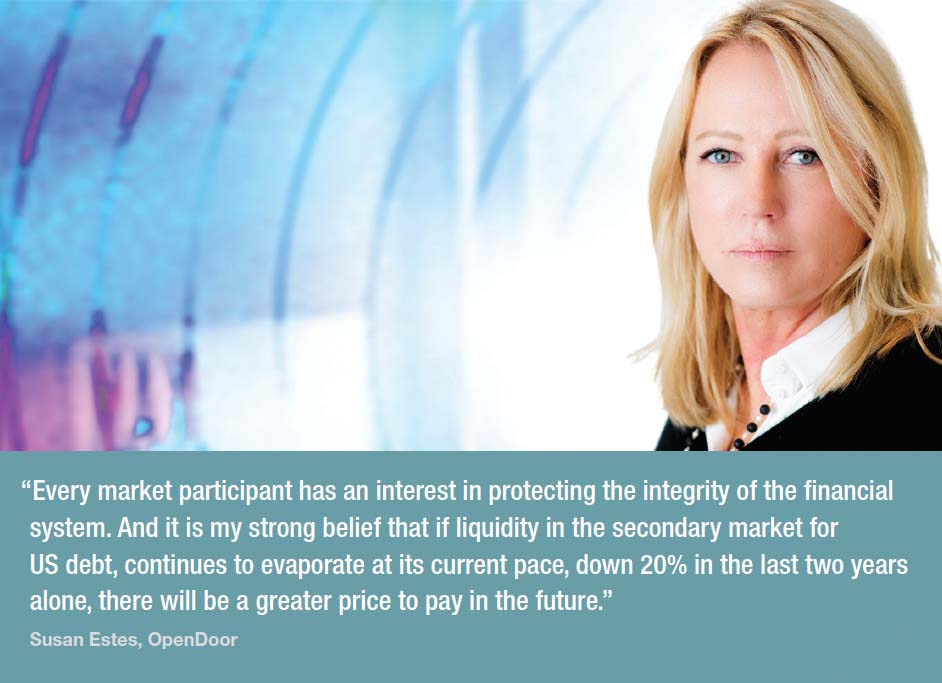Susan Estes, co-founder, CEO & President at OpenDoor speaks to The DESK and exposes the hidden risks within the US Treasury market for institutional investors.
Dealer business is perceived as declining in fixed income; how is the US Treasury market affected?
If you look at The Fed’s average daily trading volumes in US Treasuries, as well as the percentage of that volume traded by the incumbent dealers, and compare pre-crisis to post-crisis, there has not been any measurable decline. There has been an overall decline in turnover as a percentage of outstanding floating supply, but that is not the same as loss of market share.
Total outstanding supply in the US Treasury market tripled from US$4.6 trillion in 2003 to US$13.9 trillion in 2017, while absolute volumes have remained in a relatively stable trading band between the high 400,000’s and low to mid-500,000’s. That is concerning, but the decline in turnover says nothing about dealers’ market share which has actually increased, not decreased, over that same time-period.
There is a clear impression among market participants that dealers are playing a lesser role in intermediating risk, but as you point out, the numbers do not support that perception. What has changed?
First, the big have gotten bigger. The gain in market share has been concentrated among the top four or five dealers, and this comes at a significant cost to the bottom 18. Even as overall market share has increased, the majority of dealers have lost market share. This is reflected in comparison earnings.

Second, the composition of trades has changed. Prior to the crisis, off-the-run (OFTR) Treasuries traded with the same fluidity as on-the-runs (OTRs). Today, OTRs, six issues which represent less than 1.5% of total outstanding Treasury issuance, comprise nearly 69% of total daily trading volume. The remaining three-hundred plus OFTR issues, which make up the remaining 98.5%, account for less than 32% of the volume. But that number can be misleading because it is the three or four most recently auctioned OFTRs that make-up its majority. That does not bode well for secondary liquidity or market depth for the more orphaned issues that number in the hundreds.
What does that imply for the overall structural health of the Treasury market?
I think what is missed by market participants, who have little or no exposure in US Treasuries, is the role it plays as the risk-free rate for the globe. Any significant event that impacts the US debt market will have a roll-on impact on other related markets. The trillion-dollar question is whether the current market structure can support an unforeseen shock.
It’s easy for market participants to lose sight of the magnitude of floating debt when they are so used to talking in terms of billions and trillions. And some things that should matter, like reduced market turnover and reduced capacity to absorb risk, don’t seem to be on the radar.
For context, in the four-month period from July to November of last year, major foreign holders of US Treasury securities were net sellers of US$295 billion. During that period, the funds rate was stable and volatility was low. As we entered July, the 10-year note yielded 1.37%. By the end of November, it had climbed to 2.37%. Sixteen weeks, no rate change, no external shocks, and yields increased 100-bps as the market absorbed the selling. US$295 billion is just 2.1% of total outstanding issuance.
How have buy-side firms reacted to the changing market conditions in off-the-runs?
It varies. Some are actively seeking alternative ways to source disparate pools of liquidity in Treasuries, while others are focusing their efforts elsewhere.
I have been told by a few of the largest global asset managers in fixed income that they simply don’t feel the pain in Treasury execution. These are the top-tier, high volume, buy-side firms that tend to be the thought leaders for the industry, yet many of these firms are insulated from the increased transaction costs felt by the industry majority.
I believe there is a tendency for large market participants to get lulled into a false sense of comfort that their experience can be extrapolated to the rest of the market, when in fact their experience can be decidedly different.
When top-tier dealers offer favoured pricing to the top-tier high-volume buy-side firms, you have the elite playing to the elite. That kind of isolationism, in today’s consolidated market structure, can provide a false sense of comfort regarding the health of the overall market.
Greenwich Associates just published a piece, ‘Off-the-Run Treasury Trading, Understanding the Evolving Market Structure,’ which notes that when a bond goes from OTR to OFTR, transaction costs rise an average of 40%; the length of time to execute increases by one-third and market depth decreases by nearly 37%. It also notes that this is true for all but the top-tier, high-volume accounts.
I have tremendous respect for the firms who have been able to capitalise on post-crisis reform and emerge with significant market share, but I am also cautious of the concentration. When natural disasters strike, individuals and businesses that have taken precautions to build stronger structures may avoid the structural collapse of their building, only to be severely damaged, or fall into eventual bankruptcy, due to the ripple effects that follow. Not the least of which could be attributed to the economic hardship of the majority.
What should buy-side traders be cognisant of when trading in the US treasury markets?
The basics. Market dynamics matter a great deal. Every market participant has an interest in protecting the integrity of the financial system. And it is my strong belief that if liquidity in the secondary market for US debt, continues to evaporate at its current pace, down 20% in the last two years alone, there will be a greater price to pay in the future.
I don’t think I need to remind readers that the decline in yields during the US Treasury Flash Crash of 2015 eclipsed the Lehman Brother’s failure in its magnitude. Nor that it happened when interest rates were pegged at zero, in a period of historical low volatility, and when true investors, the long-term holders of US Treasury OFTRs were very comfortable with their buy-and-hold strategies.
Those that know me, know how little patience I have for soundbites. I hear all the time that securities will always “clear at a price”, and while that may be true, if there were to be an external shock of some sort such as a significant shift in monetary policy, an unexpected uptick in inflation, a macroeconomic development, a large bankruptcy or other systemic event not on our radar, I often wonder what that price would be when each 1% shift out of Treasuries as an asset class equates to a US$140 billion liquidation, into a smaller pool of dealers with capacity to take risk.
The subprime crisis of 2007, with its interrelated bets and tentacles into other associated markets, nearly took down the global financial system. And while I hope we can go decades without another challenging event, hope is not a strategy.
The present market structure, where OFTRs can be up to 180 times less liquid than OTR counterparts, has yet to be tested in a volatile rate environment of any reasonable duration. The time to explore alternative methods for transacting in these securities is well before an event takes place.
What role is OpenDoor playing in shifting the structural landscape of the global bond markets?
We exist because our team shares a belief in our collective responsibility to contribute to the integrity of the financial system. We also believe that what is good for the debt markets is good for society. Every market participant bears some level of responsibility to protect the long-term stability of what is, for better or worse, the debt market that acts as the risk-free interest rate for a multitude of other markets.
And as market participants consider whether to participate in a new venue, I believe it is important for them to consider the reasons why it exists. OpenDoor has never purported to be the solution, but it is our intent to be part of the solution.
Ours is a market-based solution. We offer inclusive, neutral, anonymous, all-to-all, session-based auctions as an alternative way to source liquidity in US OFTR Treasuries and Treasury Inflation-Protected Securities. Our platform and trading protocols have been designed to benefit the largest pool of market participants.
©Markets Media Europe 2025












